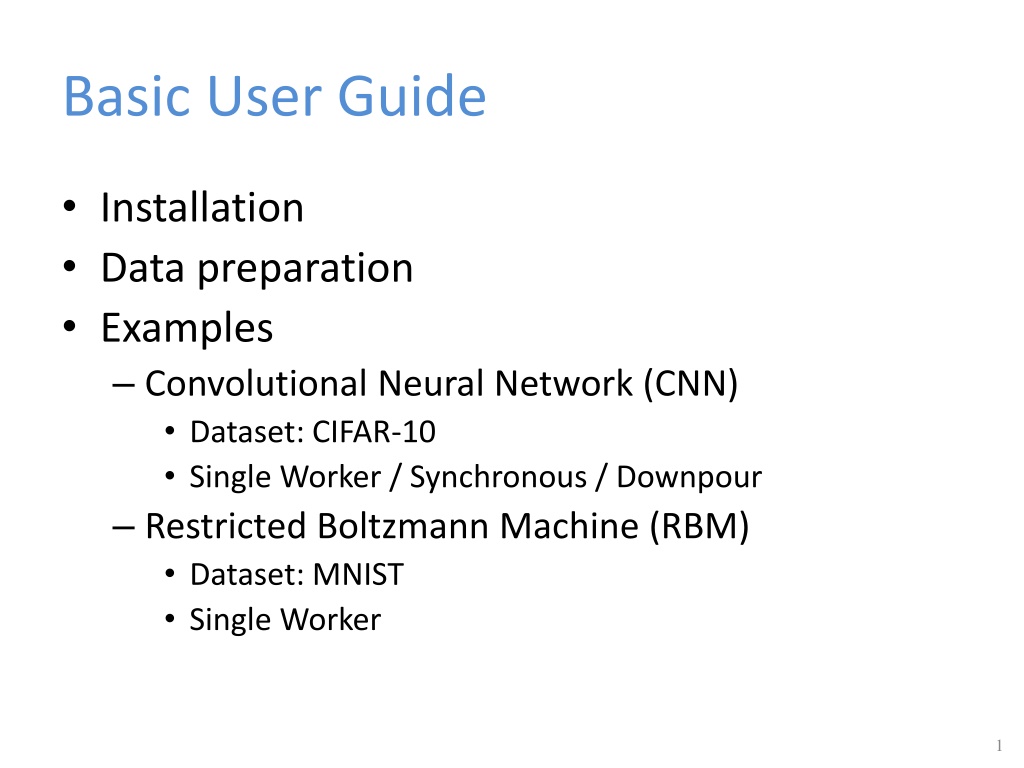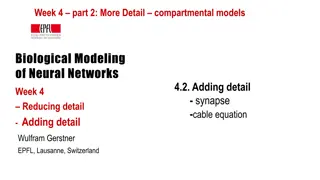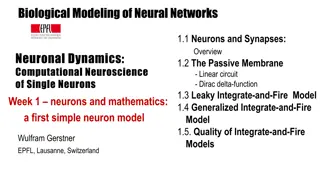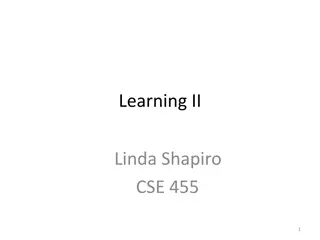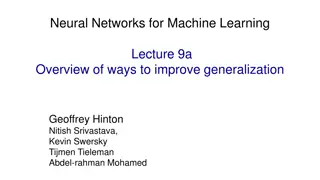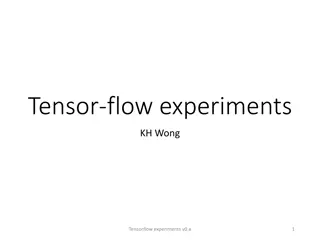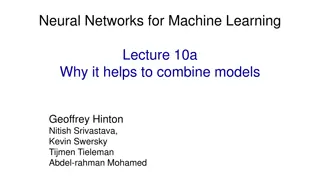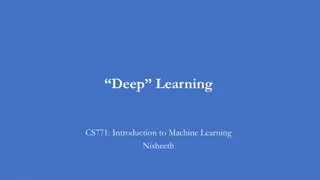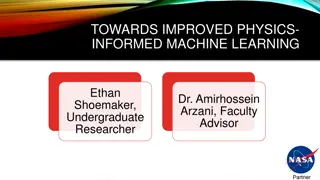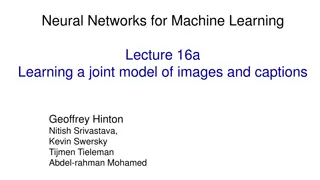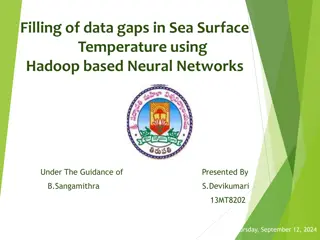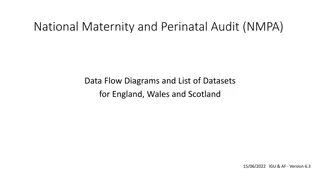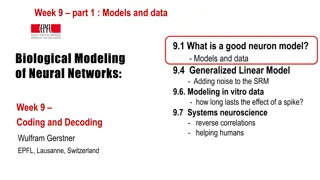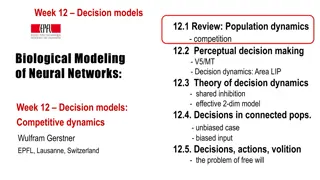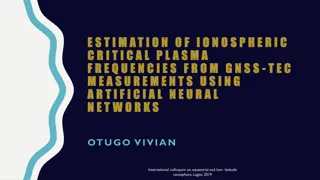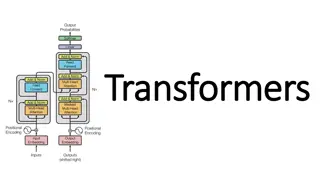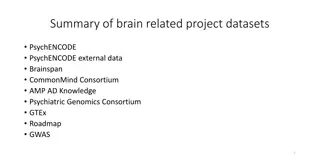Guide to Setting Up Neural Network Models with CIFAR-10 and RBM Datasets
Learn how to install Apache Singa, prepare data using SINGA recognizable records, and convert programs for DataShard for efficient handling of CIFAR-10 and MNIST datasets. Explore examples on creating shards, generating records, and implementing CNN layers for effective deep learning.
Uploaded on Sep 29, 2024 | 0 Views
Download Presentation

Please find below an Image/Link to download the presentation.
The content on the website is provided AS IS for your information and personal use only. It may not be sold, licensed, or shared on other websites without obtaining consent from the author. Download presentation by click this link. If you encounter any issues during the download, it is possible that the publisher has removed the file from their server.
E N D
Presentation Transcript
Basic User Guide Installation Data preparation Examples Convolutional Neural Network (CNN) Dataset: CIFAR-10 Single Worker / Synchronous / Downpour Restricted Boltzmann Machine (RBM) Dataset: MNIST Single Worker 1
Installation Download git clone https://github.com/apache/incubator-singa.git git clone https://git-wip-us.apache.org/repos/asf/incubator-singa.git VirtualBox Image http://www.comp.nus.edu.sg/~dbsystem/singa/docs/quick-start Username: singa Password: singa # get latest version cd singa git fetch origin master Compile ./autogen.sh ./configure make
Data Preparation SINGA recognizable Records Parse Load Parser Layers Data Records Data Layers Raw Data Imdb, leveldb, DataShard Generate data records convert program Support user-defined record format (and parser layer) Use data records corresponding data/parser layer as input
Convert program for DataShard // a built-in lightweight data layer class DataShard { bool Insert(const std::string& key, const google::protobuf::Message& tuple); // write bool Next(std::string* key, google::protobuf::Message* val); // read }; Message SingleLabelmageRecord { repeated int32 shape; // the shape of contained data, e.g. 32*32 for a image optional int32 label; // label for classification optional bytes pixel; // pixels of a image repeated float data; // feature vector }; singa::DataShard myShard(outputpath, kCreate); singa:: SingleLabelmageRecord record; record->add_shape( int_val ); // for repeated field record->set_label( int_val ); // key (string) is a unique record ID (e.g., converted from a number starting from 0) myShard.Insert( key, record );
Prepared Datasets Datasets CIFAR-10[1] MNIST[2] Generate records examples/cifar10/create_shard.cc examples/mnist/create_shard.cc # go to example folder $ cp Makefile.example Makefile $ make download # download raw data $make create # generate data records Already done for you in virtualbox [1] http://www.cs.toronto.edu/~kriz/cifar.html [2] http://yann.lecun.com/exdb/mnist/
Examples (CNN) layer { name: "data" type: kShardData sharddata_conf { path: "examples/cifar10/cifar10_train_shard" batchsize: 16 random_skip: 5000 } exclude: kTest # exclude for the testing net } layer { name: "data" type: kShardData sharddata_conf { path: "examples/cifar10/cifar10_test_shard batchsize: 100 } exclude: kTrain # exclude for the training net }
Examples (CNN) layer { name:"rgb" type: kRGBImage srclayers: "data" rgbimage_conf { meanfile: "examples/cifar10/image_mean.bin" # normalized image feature } } layer { name: "label" type: kLabel srclayers: "data" }
Examples (CNN) layer { name: "conv1" type: kConvolution srclayers: "rgb" convolution_conf { } param { name: "w1" init { type: kGaussian } } param { name: "b1" lr_scale:2.0 init { type: kConstant } } }
Examples (CNN) layer { name: "pool1" type: kPooling srclayers: "conv1" pooling_conf { } } layer { name: "relu1" type: kReLU srclayers:"pool1" } layer { name: "norm1" type: kLRN srclayers:"relu1" lrn_conf { } }
Examples (CNN) layer { name: "ip1" type: kInnerProduct srclayers:"pool3" innerproduct_conf { } param { } } layer { name: "loss" type: kSoftmaxLoss softmaxloss_conf { } srclayers:"ip1 srclayers: "label }
Configure a CNN Job 4 Main Components NeuralNet (as configured above) Updater updater { type: kSGD learning_rate { type: kFixedStep } } TrainOneBatch alg: kBP ClusterTopology
Run a CNN Job A quick-start job Default ClusterTopology (single worker) Provided in Run it! examples/cifar10/job.conf # start zookeeper (do it only once) $ ./bin/zk-service start # run the job using default setting $ ./bin/singa-run.sh -conf examples/cifar10/job.conf # stop the job $ ./bin/singa-stop.sh
Run a CNN Job Record job information to /tmp/singa-log/job-info/job-2-20150817-055601 Executing : ./singa -conf /xxx/incubator-singa/examples/cifar10/job.conf -singa_conf /xxx/incubator- singa/conf/singa.conf -singa_job 2 E0817 06:56:18.868259 33849 cluster.cc:51] proc #0 -> 192.168.5.128:49152 (pid = 33849) E0817 06:56:18.928452 33871 server.cc:36] Server (group = 0, id = 0) start E0817 06:56:18.928469 33872 worker.cc:134] Worker (group = 0, id = 0) start E0817 06:57:13.657302 33849 trainer.cc:373] Test step-0, loss : 2.302588, accuracy : 0.077900 E0817 06:57:17.626708 33849 trainer.cc:373] Train step-0, loss : 2.302578, accuracy : 0.062500 E0817 06:57:24.142645 33849 trainer.cc:373] Train step-30, loss : 2.302404, accuracy : 0.131250 E0817 06:57:30.813354 33849 trainer.cc:373] Train step-60, loss : 2.302248, accuracy : 0.156250 E0817 06:57:37.556655 33849 trainer.cc:373] Train step-90, loss : 2.301849, accuracy : 0.175000 E0817 06:57:44.971276 33849 trainer.cc:373] Train step-120, loss : 2.301077, accuracy : 0.137500 E0817 06:57:51.801949 33849 trainer.cc:373] Train step-150, loss : 2.300410, accuracy : 0.135417 E0817 06:57:58.682281 33849 trainer.cc:373] Train step-180, loss : 2.300067, accuracy : 0.127083 E0817 06:58:05.578366 33849 trainer.cc:373] Train step-210, loss : 2.300143, accuracy : 0.154167 E0817 06:58:12.518497 33849 trainer.cc:373] Train step-240, loss : 2.295912, accuracy : 0.185417
SINGA Scripts Launch singa jobs singa-run.sh -conf <job config file> [ other arguments ] -resume -exec <path to mysinga> : if want to use own singa driver : if want to recover a job Manage singa jobs singa-console.sh <command> <args> list view <job id> : view procs of a singa job kill <job id> : kill a singa job" : list running singa jobs Stop all singa processes singa-stop.sh
Run CNN (cont.) Synchronous Training 2 workers in a single process # default setting cluster { nworker_groups: 1 nserver_groups: 1 nworkers_per_group: 1 nservers_per_group: 1 nworkers_per_procs: 1 nservers_per_procs: 1 server_worker_separate: false } cluster { nworkers_per_group: 2 nworkers_per_procs: 2 } Asynchronous Training downpour 2 worker groups and 1 global server group cluster { nworker_groups: 2 nservers_per_group: 2 }
Examples (RBM-Auto Encoder) 4 RBM and 1 Auto-encoder Need to pre-train models one by one How to use parameters from previous models? checkpoint_path: "examples/rbm/rbm0/checkpoint/step6000-worker0.bin" Check points are output files from a model When load check points for a new model, SINGA puts parameters values into the parameter with the same identity name
Run RBM-Auto Encoder # at SINGA_HOME/ $ ./bin/singa-run.sh -conf examples/rbm/rbm0.conf $ ./bin/singa-run.sh -conf examples/rbm/rbm1.conf $ ./bin/singa-run.sh -conf examples/rbm/rbm2.conf $ ./bin/singa-run.sh -conf examples/rbm/rbm3.conf $ ./bin/singa-run.sh -conf examples/rbm/autoencoder.conf
